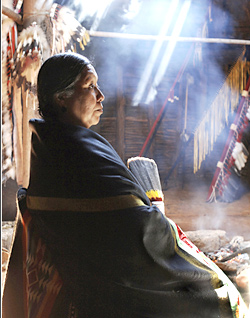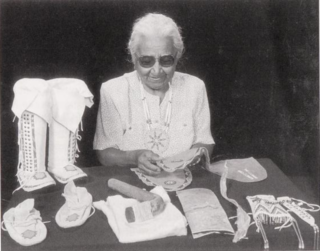Related Research Articles

Beadwork is the art or craft of attaching beads to one another by stringing them with a sewing needle or beading needle and thread or thin wire, or sewing them to cloth. Beads come in a variety of materials, shapes and sizes. Beads are used to create jewelry or other articles of personal adornment; they are also used in wall hangings and sculpture and many other artworks.

Fancy dance, Pan-Indian dancing, Fancy Feather or Fancy War Dance is a style of dance some believe was originally created by members of the Ponca tribe in the 1920s and 1930s, in an attempt to preserve their culture and religion. It is loosely based on the War dance. Fancy dance was considered appropriate to be performed for visitors to reservations and at "Wild West" shows. But today, fancy dancers can be seen at many powwows across the nation and even the world.

Gilcrease Museum, also known as the Thomas Gilcrease Institute of American History and Art, is a museum northwest of downtown Tulsa, Oklahoma housing the world's largest, most comprehensive collection of art of the American West, as well as a growing collection of art and artifacts from Central and South America. The museum is named for Thomas Gilcrease, an oil man and avid art collector, who began the collection. He deeded the collection, as well as the building and property, to the City of Tulsa in 1958. Since July 1, 2008, Gilcrease Museum has been managed by a public-private partnership of the City of Tulsa and the University of Tulsa. The Helmerich Center for American Research at Gilcrease Museum was added in 2014 at a cost of $14 million to provide a secure archival area where researchers can access any of the more than 100,000 books, documents, maps and unpublished materials that have been acquired by the museum.

Acee Blue Eagle was a Native American artist, educator, dancer, and Native American flute player, who directed the art program at Bacone College. His birth name was Alexander C. McIntosh, he also went by Chebon Ahbulah, and Lumhee Holot-Tee, and was an enrolled member of the Muscogee (Creek) Nation.
The Kiowa Six, previously known as the Kiowa Five, is a group of six Kiowa artists from Oklahoma in the early 20th century, working in the "Kiowa style". The artists were Spencer Asah, James Auchiah, Jack Hokeah, Stephen Mopope, Monroe Tsatoke and Lois Smoky.

Juanita Growing Thunder Fogarty is a Native American, Assiniboine Sioux bead worker and porcupine quill worker. She creates traditional Northern Plains regalia.

Martha Berry is a Cherokee beadwork artist, who has been highly influential in reviving traditional Cherokee and Southeastern beadwork, particularly techniques from the pre-Removal period. She has been recognized as a Cherokee National Treasure and is the recipient of the Seven Star Award and the Tradition Keeper Award. Her work is shown in museums around the United States.
Archie Blackowl was a Cheyenne painter from Oklahoma who played a pivotal role in mid-20th century Native American art. "Leave a mark. Put something down so that when the young people see it they will understand." –Archie Blackowl, July, 1975
Spencer Asah was a Kiowa painter and a member of the Kiowa Six from Oklahoma.
Stephen Mopope (1898–1974) was a Kiowa painter, dancer, and Native American flute player from Oklahoma. He was the most prolific member of the group of artists known as the Kiowa Six.
Lois Smoky Kaulaity (1907–1981) was a Kiowa beadwork artist and a painter, one of the Kiowa Six, from Oklahoma.

Vanessa Paukeigope Santos Jennings is a Kiowa/Kiowa Apache/Gila River Pima regalia maker, clothing designer, cradleboard maker, and beadwork artist from Oklahoma.
The Bacone school or Bacone style of painting, drawing, and printmaking is a Native American intertribal "Flatstyle" art movement, primarily from the mid-20th century in Eastern Oklahoma and named for Bacone College. This art movement bridges historical, tribally-specific pictorial painting and carving practices towards an intertribal Modernist style of easel painting. This style is also influenced by the art programs of Chilocco Indian School, north of Ponca City, Oklahoma, and Haskell Indian Industrial Training Institute, in Lawrence, Kansas and features a mix of Southeastern, Prairie, and Central Plains tribes.

Carl Sweezy (1881–1953) was a Southern Arapaho painter from Oklahoma. He painted individual portraits, but was best known for his portrayals of ceremonies and dances.

Richard Aitson is a Kiowa-Kiowa Apache bead artist, curator, and poet from Oklahoma.
Jamie Okuma is a Native American visual artist and fashion designer from California. She is known for beadwork, mixed-media soft sculpture, and fashion design. She is Luiseño and Shoshone-Bannock.
Tahnee Ahtoneharjo-Growingthunder is an American Kiowa, Muscogee, and Seminole beadwork artist, regalia maker, curator, and museum professional from Mountain View, Oklahoma.

Alice Littleman was a Kiowa beadwork artist and regalia maker, who during her life time was recognized as one of the leading Kiowa beaders and buckskin dressmakers. Her works are included in the permanent collections of the National Museum of Natural History, the National Museum of the American Indian, the Southern Plains Indian Museum, and the Oklahoma Historical Society.
Solomon McCombs was a Native American artist from Oklahoma known for his paintings, murals, and illustrations.
References
- 1 2 3 Pearson-Little Thunder, Julie (November 8, 2012). "Oral history interview with Judy Coser". Oklahoma Native Artists. Retrieved 23 July 2020.
- ↑ "Red Earth Art Winners Announced". The Oklahoman. online digital archives. Retrieved 30 April 2015.
- ↑ "Sac and Fox Tribal Members Recipients" (PDF). sacandfoxnation-nsn.gov. Sac and Fox News. Retrieved 30 April 2015.
- ↑ "Oklahoma Celebrates Elders at 4th Annual Indian Elder Honors". aarp.org. AARP. Retrieved 29 April 2015.